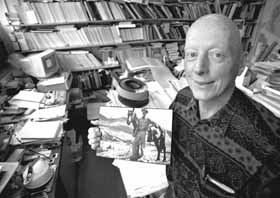
| ||
 | ||
 Professor Eric Mountjoy revisits his past: the photo he's holding was taken in 1958 while he was a PhD student doing field work in Jasper National Park. PHOTO: OWEN EGAN |
Scaling the heights of his profession
|
SHAUN GOHO | What's in a name? For McGill's Eric Mountjoy, perhaps something deeply prophetic. Mountjoy, a professor of earth and planetary sciences, claims to have had a lifelong "love affair with the Rockies," whose stunning peaks have brought him both personal pleasure and academic prestige.
Growing up in nearby Calgary in the 1930s and '40s, he regularly visited the mountains, savouring their wild beauty. This early attraction led him into a career of research and study that has seen him become recognized as one of the world's foremost experts on the geology of the Rocky Mountains and in the field of sedimentology "What he is most famous for," according to former master's student and current departmental colleague Dr. Jeanne Paquette, "is that he pieced together a lot of the structure and the stratigraphy [the composition and distribution of rocks and earth], which is really complex, in the Jasper National Park area of the Rockies." Last May, Mountjoy's achievements were recognized by the Geological Association of Canada, which awarded him the Logan Medal, their highest award. Furthermore, his work in the field of sedimentology will be honoured by the Society for Sedimentary Geology in May 1998 when he will be presented with the prestigious Pettijohn Medal. One remarkable aspect of Mountjoy's career has been his ability to move back and forth from the particular to the general with consummate ease. "He has this tremendous capacity for seeing where the details fit into the much larger picture," says Paquette. On one hand, much of his work has been concentrated on Jasper Park's Miette area, and in particular on its exposed coral reefs from the Devonian period (395 million to 345 million years ago). But he has also been able to use the observations made there to develop broader ideas, which he has then applied to sites he has visited in places like Australia, China and Germany. Despite being best known for his work on sedimentology, Mountjoy sees himself as a "generalist." Indeed, the list of fields other than sedimentology in which he has worked is impressive: ancient and modern reef geology, carbonate petrology and diagenesis, carbonate reservoirs and stratigraphy. Geologists study rocks, the very image of immobility and stasis. Yet for Mountjoy, geology is a study of change, of process, of history. He describes studying "sub-aqueous debris flows," the remains of ancient, underwater avalanches now frozen in stone. The excitement is noticeable in his usually calm voice as he recalls a field trip to Australia. Upon visiting a site, he immediately recognized it as such a debris flow, though it had been characterized as something quite different by previous workers. It's as though, in a sudden flash of insight, he could actually see the rocks tumbling down again. While Mountjoy is modest about his teaching abilities, his methods have clearly appealed to the dozens of graduate students he has supervised in more than 30 years at McGill. "He has a very gentle approach," explains Paquette, "but he also wants to see you struggle with the problem and find as much of the answer as you can on your own. Then he will help you go one step further." Paquette adds that Mountjoy offers more than academic training to his students. She cites the mentoring he offers as capable of "paving the way" for a student. "He stands out for having had students who have gone on to high positions in research as well as in industry, and who have then come back to McGill to hire new students." At an age when most people have retired or are seriously considering it, Mountjoy shows no signs of slowing down. He was in his beloved Rockies this past summer, continuing his surveying work in what he thinks was his 46th field season. "We have only just scratched the surface of these fascinating mountains," he explains. "There is still so much more to uncover and integrate into new models. I'm still doing field work every summer, scrambling up and down the mountainsides. And as long as I keep healthy, I'm going to keep going out there."
|
|
| |||||